Basketball drills

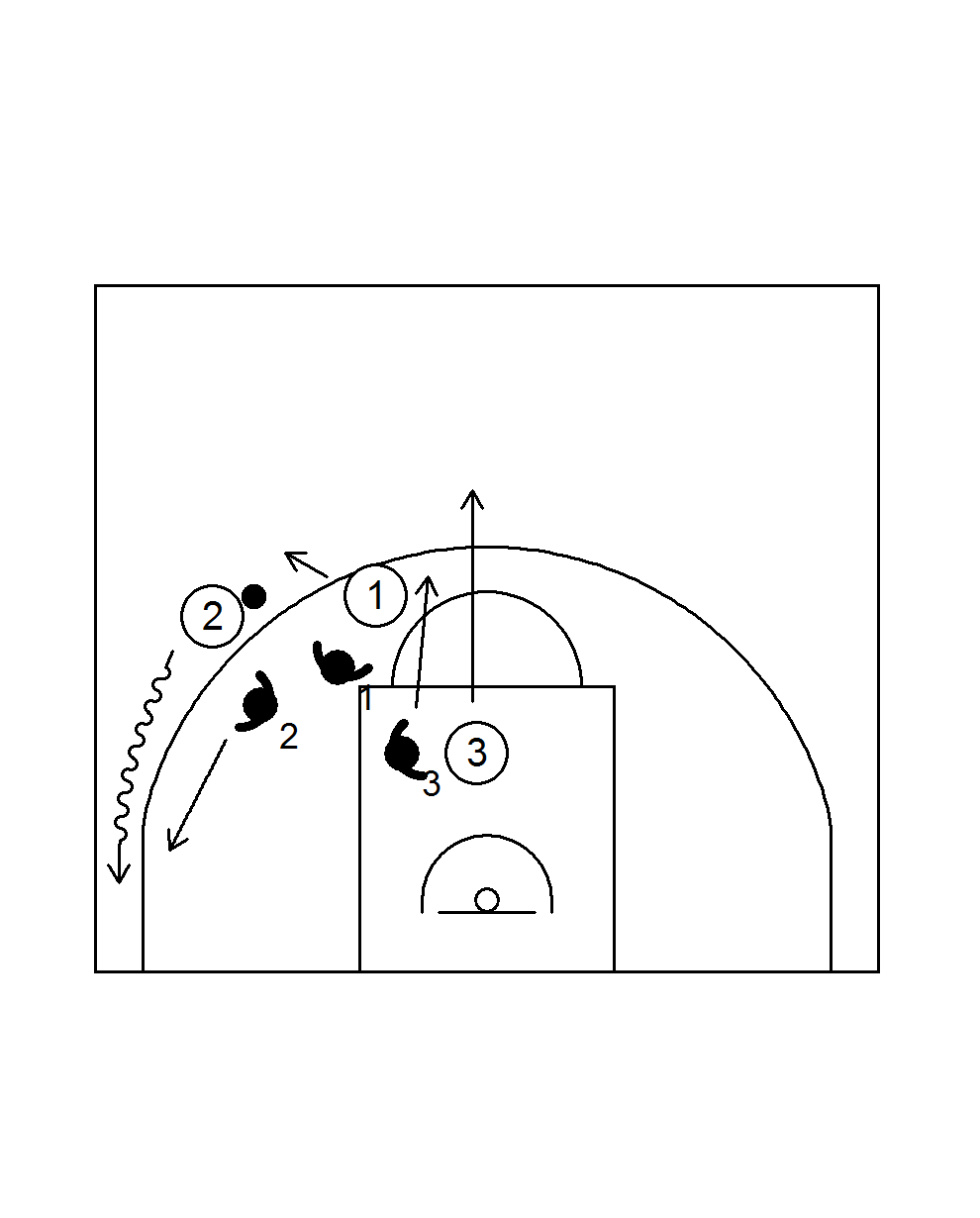
Goal: to defend one pass away
Organization:
- attackers use quarter of the field
- try to get free with in-out or cut
- first restore balance by occupying the 3 positions before cutting again
- defender overplays when his man is playable with one pass
- attacker can dribble
- a waiting player counts down 20 seconds
Teaching Points:
- hand in the passing line
- front foot in the passing line
- catch your man with your forearm
- 3/4 of your attention on the man, 1/4 on the ball
- NO help
- change after x stops
Form of play:
- each team gets 5x ball possession
- who makes the most stops
Goal:
- shot from the elbow
- outlet pass after score
- overhead pass from low post to elbow
Organization:
- after shot rebound and immediately step over the back line and take the ball
- always chase your ball and take the next position
- set a goal; e.g. 30 shots.
Teaching Points:
- in the last step bring the ball above your head and turn your face towards the pitch
- Tight overhead pass to the outlet
- ask high for the ball
- Pass the ball in the shot hand
Variations:
- counterclockwise and clockwise
- Fill up waiting time at the forward position with fake passes
- The other way round: after scoring, pass to the elbow and shoot from the corner
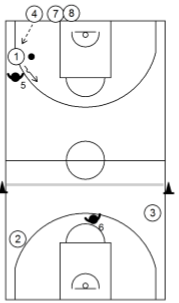
Prerequisites:
players on the dribble can defend Â- and can make a pass the length of the field
Objective:
to practice defending the backfield in the arrowpress Â- to anticipate the pass and always make sure you are in a position to intercept it
Organisation:
- 4 takes the ball and then does not take part in the game anymore, but counts down the seconds
- defender 5 applies maximum pressure on the dribbler
- the defenders can defend all over the field
- attacker 1 may only act on the defensive half Â- attackers 2 and 3 only on the offensive half
- after a stop or score, defender 5 takes the ball back for the next round
- if the attackers score within 10 seconds they have a point Â- if not, it is a point for the defenders Â- the attacker calls if there is a foul on him. Point for the attack.
- play 5 times in a row with the same defenders
- 3 new attackers each time.
- If the defenders make less than 2 stops, they must run.
- when there are 2 or more stops, all attackers must run.
Teaching points:
defend the dribbler on your feet - he may not pass you under any circumstances Â- arms wide to make a pass difficult Â- defender 6 must anticipate the long pass to intercept it Â- must position himself so that he can see the ball AND both other attackers as much as possible (split vision) Â- always adjust his position on the field to intercept the most likely pass Â- if he has not been able to intercept the long pass, Â- He must NOT allow a lay up Â- Defender 5 must then sprint full speed towards the free attacker on the weak side.
Variations:
In the beginning, you may have to limit the space for attackers 2 and 3. Use existing lines on the floor, or place pawns on the sidelines on the attacking half.
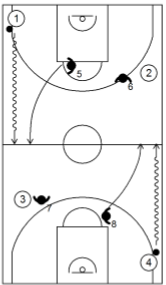
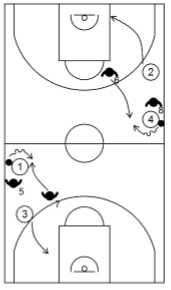
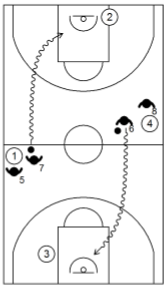
Requirements:
players must be able to individually defend the man with the ball Â- players must be able to dribble
Objective:
Force the dribbler to make a reverse dribble at the sideline and second defender goes for the steal.
Organization:
- 2 against 2 across the length
- losers must defend in the next round
- the trapper anticipates the reverse of the dribbler and taps the ball away as soon as the dribbler has turned 180 degrees Â- completes the lay up on the other basket
- a steal is 3 points Â- a 'normal score' by the attackers is 1 Â- the pair that has 12 points first wins Â- losers walk suicide
Teaching Points:
defender forces dribbler to the side, but must keep an appropriate distance, taking into account the dexterity and speed of the dribbler Â- defender must force the dribbler to the side so that he will make a reverse dribble
Variations:
- left and right
- with triplets half court; third defender must release his own man as soon as the attempted steal begins and cut off passing lines
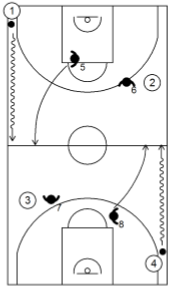
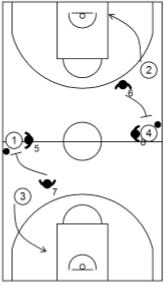
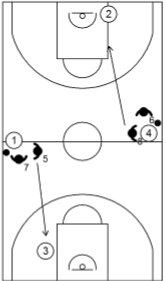
Requirements:
players must be able to individually defend the man with the ball Â- players must be able to dribble
Objective:
Set up kick directly over the center line.
Organization:
2 against 2 across the longitudinal half Â- losers must defend in the next round Â- the dribbler must be over the centre line within 4 seconds (the trapper counts down)
the trapper moves aggressively towards the half way line just before the dribbler crosses it (but due to his speed and the position of his defender is not able to change direction) Â- the trapper widens himself, but moves the foot closest to the touchline backwards slightly, so that he can close the touchline with 1 or 2 slides Â- the dribbler must never pass between the two defenders
As soon as the dribbler grabs the ball, the trapper stays with it Â- the other defender sprints towards the free attacker
Teaching Points:
defender forces the dribbler to the side, but must keep an appropriate distance, taking into account the dexterity and speed of the dribbler Â- defender must force the dribbler to move at high speed along the touchline to the attacking half
Variations:
left and right
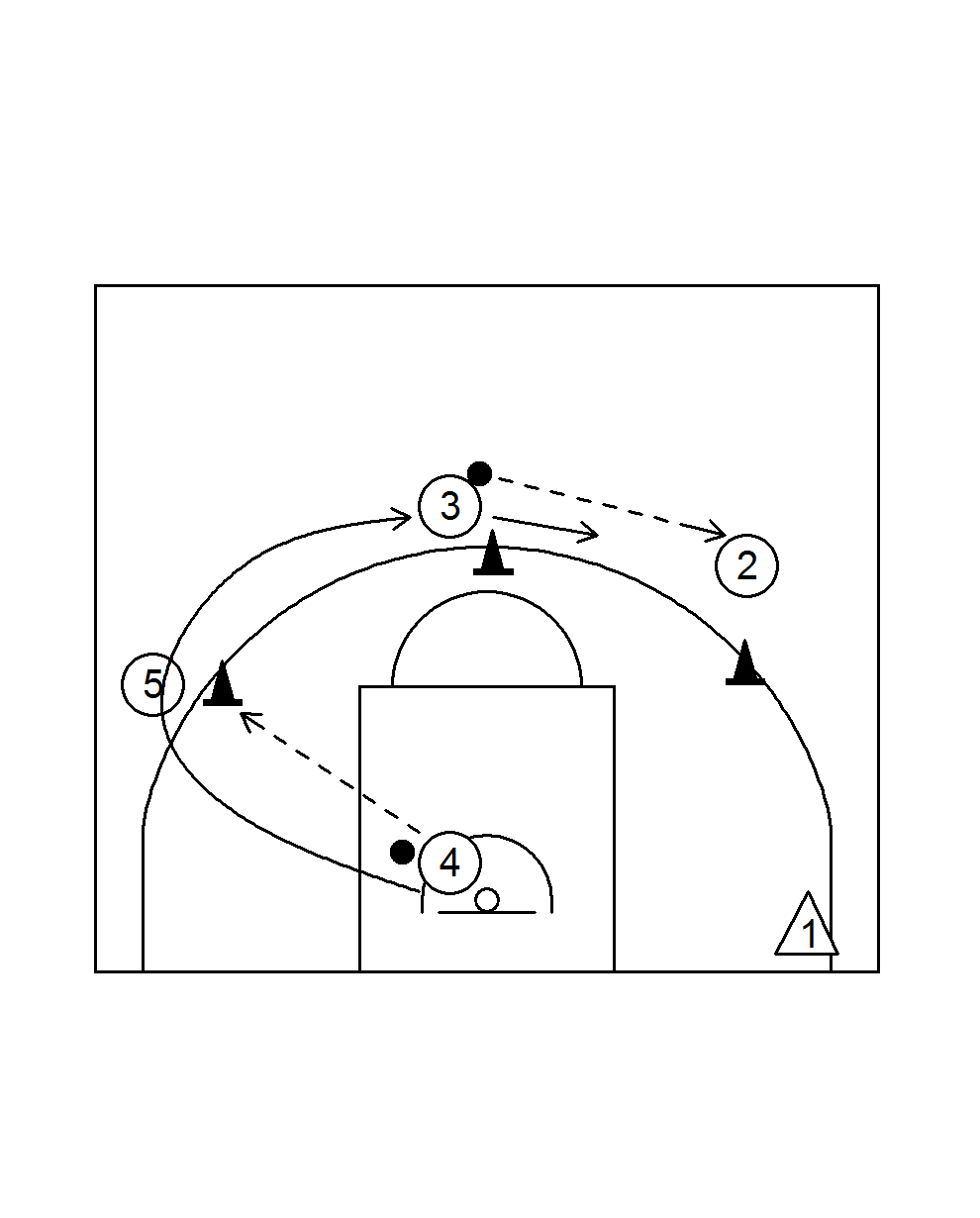
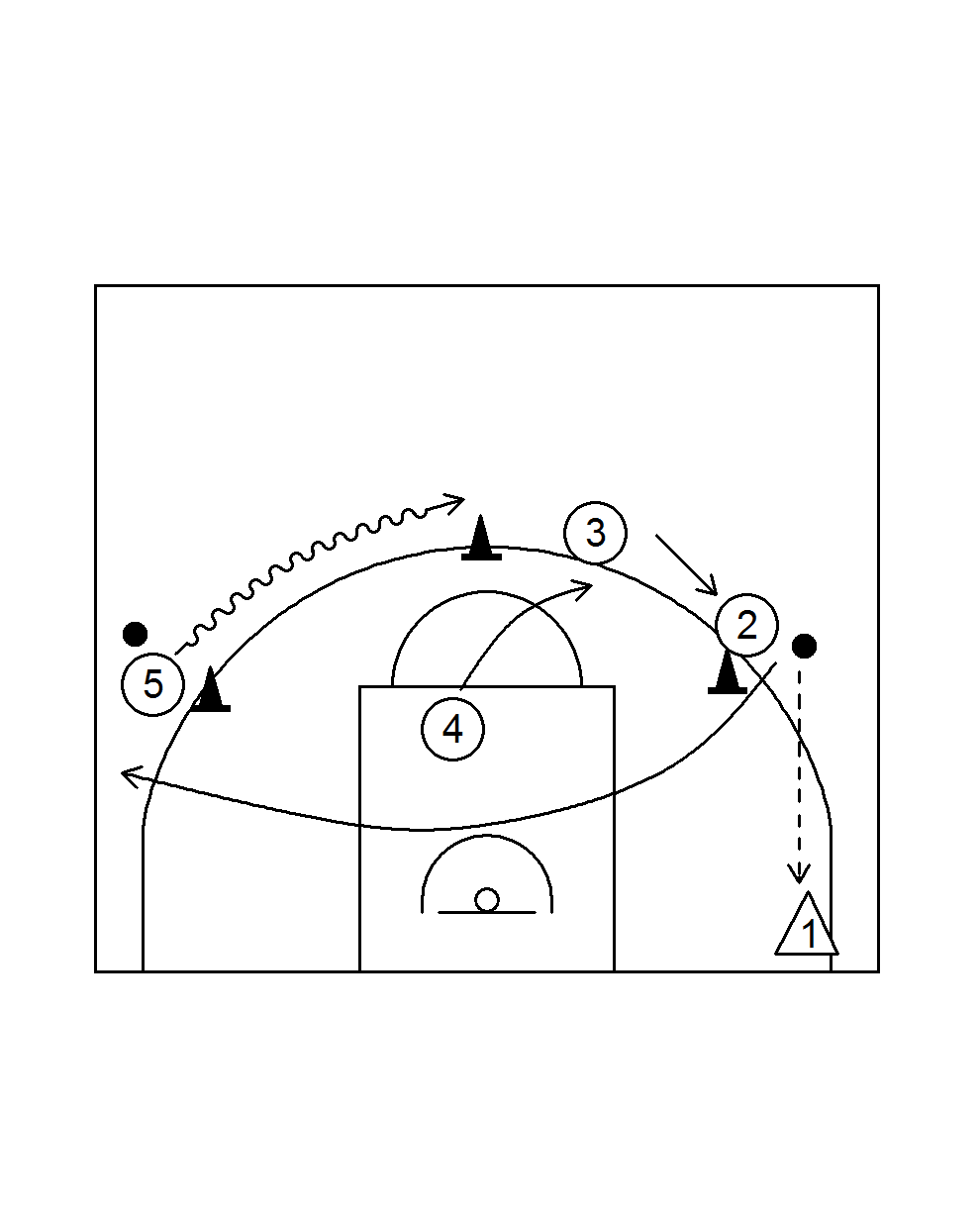
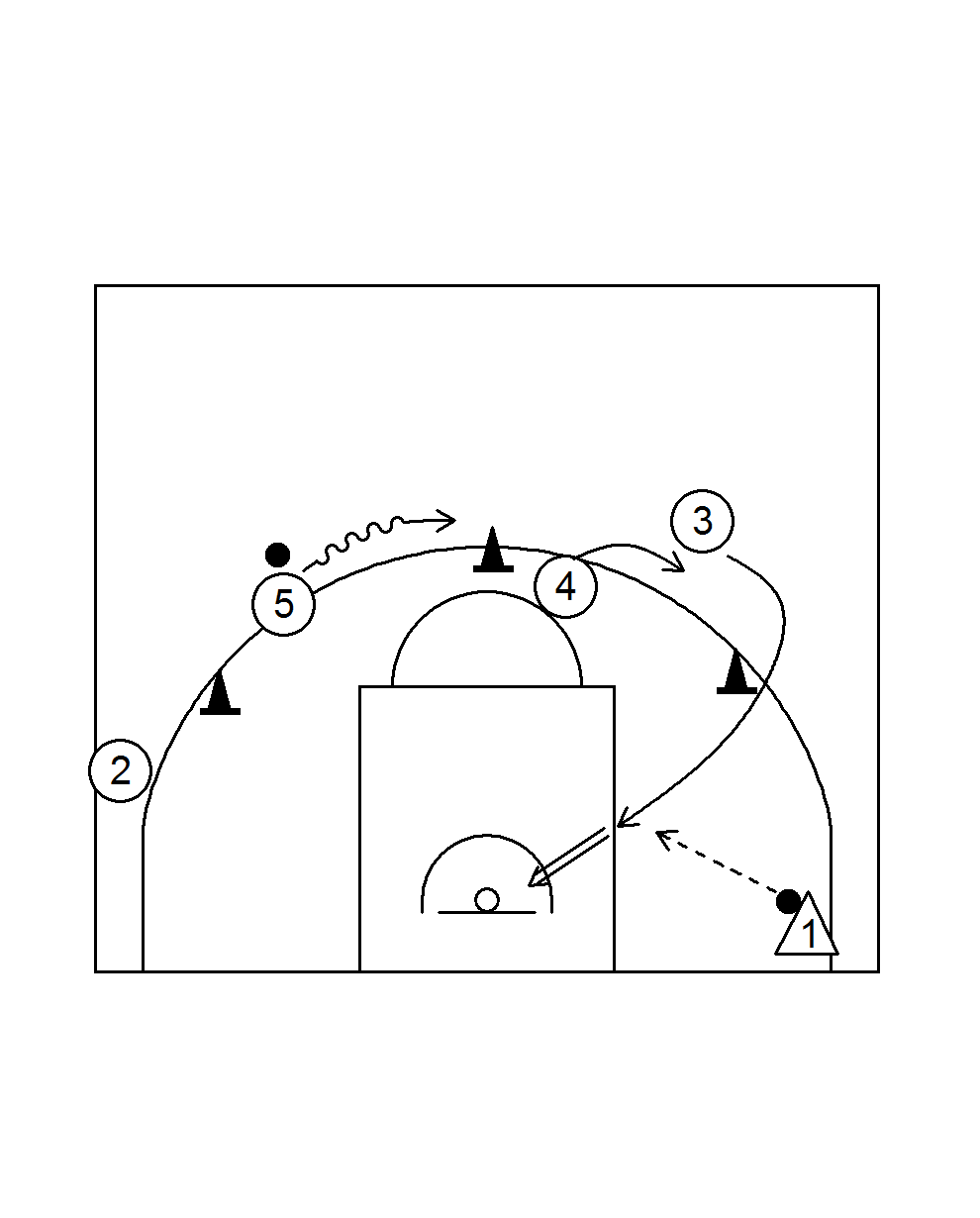
Requirements:
players must be able to make a lay up from the pass
Goal: learn the
running move to free another player + have the courage NOT to pass to the first man who moves
Organisation:
- 3 pawns
- fixed pair
- fixed passer in the corner of the field.
- adjust deep post
- cut in, ask for the ball and pass
- second incider gets the ball and makes the lay up
- catches it himself
- passes to the oulet
- and runs to the pawn on the other side of the free throw line
- in the meantime, the man with the ball dribbles to the next pawn
- passes to his regular teammate
- who passes to the regular passer in the corner
- cuts in and asks for the ball (but does not get it)
- when there are more than 10 men: make 5 free throws and then change with a fixed passer
Teaching Points:
- the first man to cut in must look at the passer and ask for the ball with his hands
- the passer must use pass fakes to keep his defender out of the pass line until the second man cuts in
Variations:
Left and right
Requirements:
- players must have the courage to shoot defensively
- and control a feint + dribble + shot or drive
Goal:
practice1
against 1
Organisation:
- after a goal attempt, each player catches his own ball
- waits until his team-mate is in his shooting position.
- passes the ball and defends the attacker.
- the attacker uses the space left by the defender for a shot or drive
- or lures the defender towards him with a shot fake and then makes a drive to the basket
- OR a bounce + step + shot
- do NOT introduce an element of competition to prevent defenders from making hard fouls to avoid losing.
- Make sure the attacker gets the ball where he can actually shoot, so the defender has to consider the shot AND the drive.
Teaching points:
- Catch the ball in your shot hand (ready to shoot).
- adjust shooter well
- shooting technique
- if a player never shoots but always makes a drive, instruct the defender to only defend the drive hard and leave room for the shot
Variations:
- shot distance
- Position in relation to the basket.
Requirements:
players must be able to drive and shoot from the 3-point line
Goal:
practice different techniques to score from the forward position
Organization:
- Attacker 3 sprints after the pass directly to the forward position.
- gets the ball there
- and attacks the basket with a high speed of action.
- Starts to land in 2TR and shoots.
- while finishing underneath the basket, always picks up the ball
- with a big approach step to the desired position under the hoop
- Pull on the other foot
- and take off with two feet
Rotation:
- the passer takes a step backwards to make room for the next passer.
- the archer catches the ball and passes it to the passer
- who joins the back of the row with the ball
- the shooter takes the position of the passer.
Catch and go:
- catch the ball and attack directly at the elbow
- sharp change of direction
- high speed
Mtm offense
Jump back:
- Attack the elbow
- Offset under the elbow on your front foot and jump backward
- pick up the ball and shoot
Jump back and drive:
- Attack the elbow
- Jump back and drive: attack the elbow, push off under the elbow onto your front foot and jump backwards
- do not pick up the ball, but change hands and attack the basket at the weak side
1 on 1
- the passer is now slightly deeper
- As soon as he has passed to the forward, he starts defending
- the attacker applies the different techniques he practised before
Rotation:
the pair that has finished the 1v1 move together to the centre line and swap roles OR the loser defends.
Variations:
- left and right
- place the passer in the corner or on the block
- different techniques of finishing under the board
- adding a help defender to the weak side, so that the attacker also learns what (im)possibilities are there.
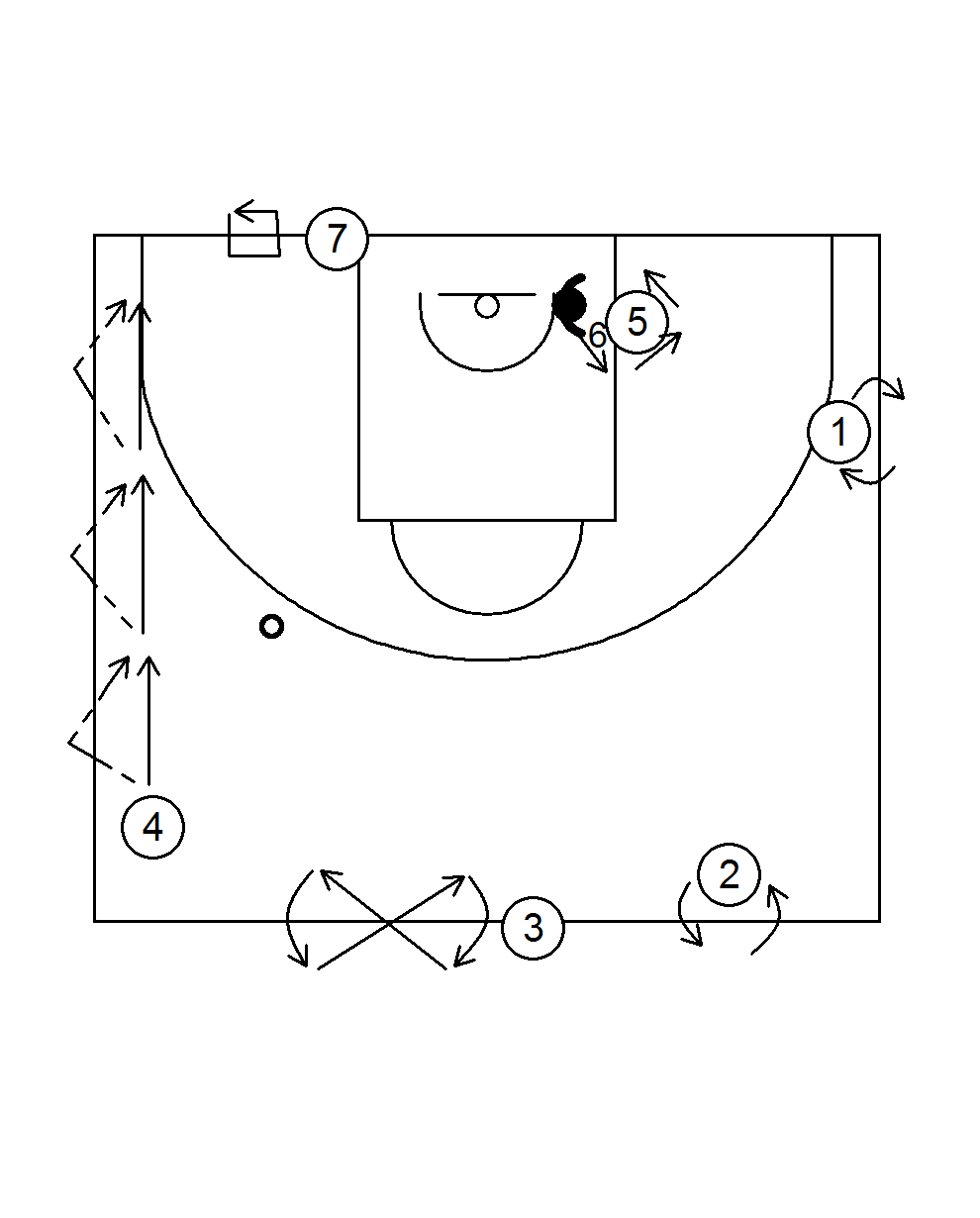
Requirements:
players must know what the correct defensive posture is have
Goal:
- reinforce good habits regarding defensive position
- To increase speed and flexibility of footwork
Organisation:
- do as circuit, 1 minute each time
- player 1 jumps sideways with 2 feet left and right of the line
- player 2 does that forwards and backwards.
- players jump with 2 feet forward wide - narrow - wide. With a jump in the air they do a 180 degree jump and start over again.
- player 4 passes the ball through the wall to himself and goes with slides to the position where he catches it again. Makes it more and more difficult for himself by increasing the distance.
- player 5 defends the mid post and chooses every time another position (behind, swim over - full front - swim over low and back again)
- player 7 makes a square with jumps on 1 foot (feather by landing) always 2x with right, then 2x with left. First left, then right etc.
Teaching points:
- knees bent
- head above the
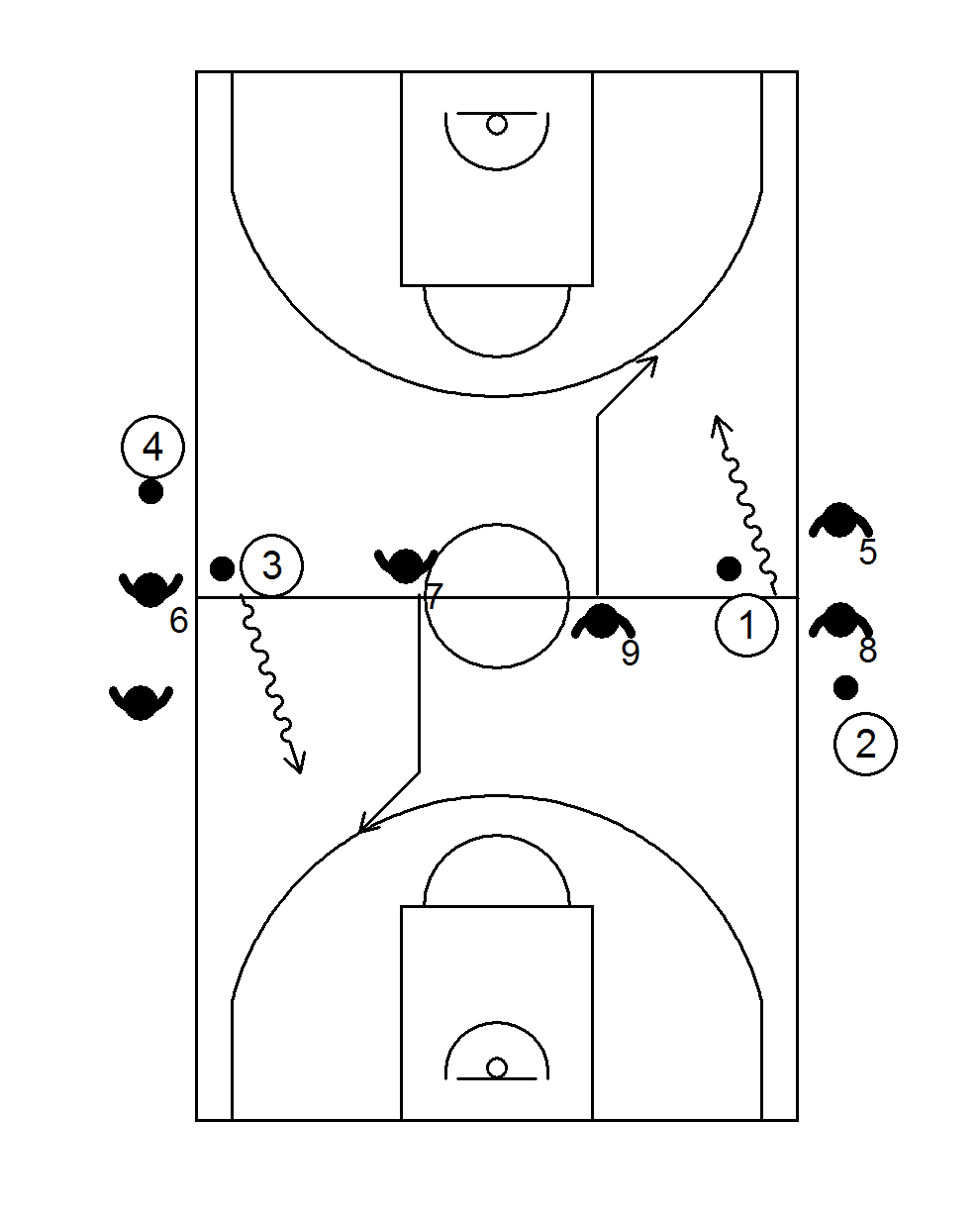
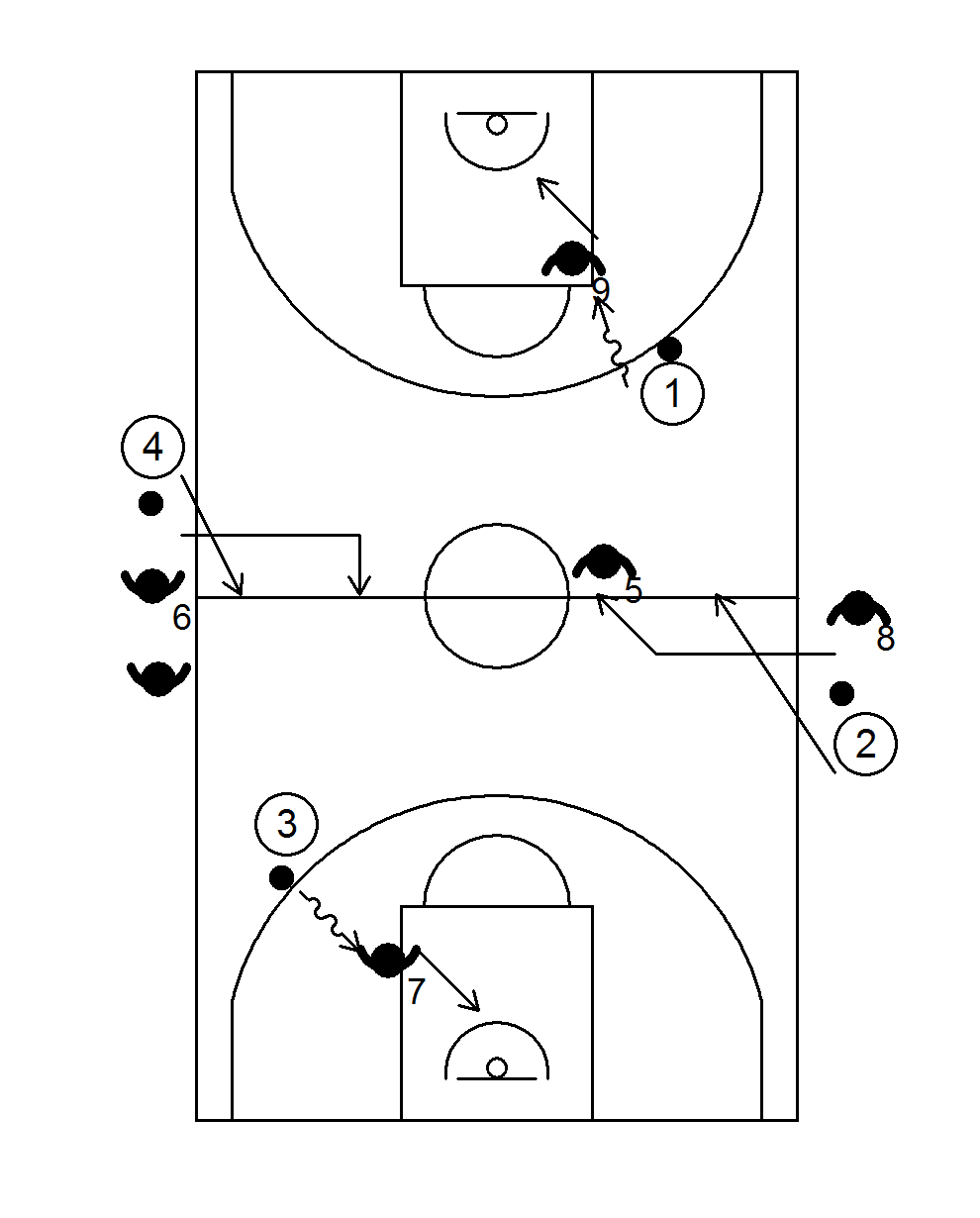
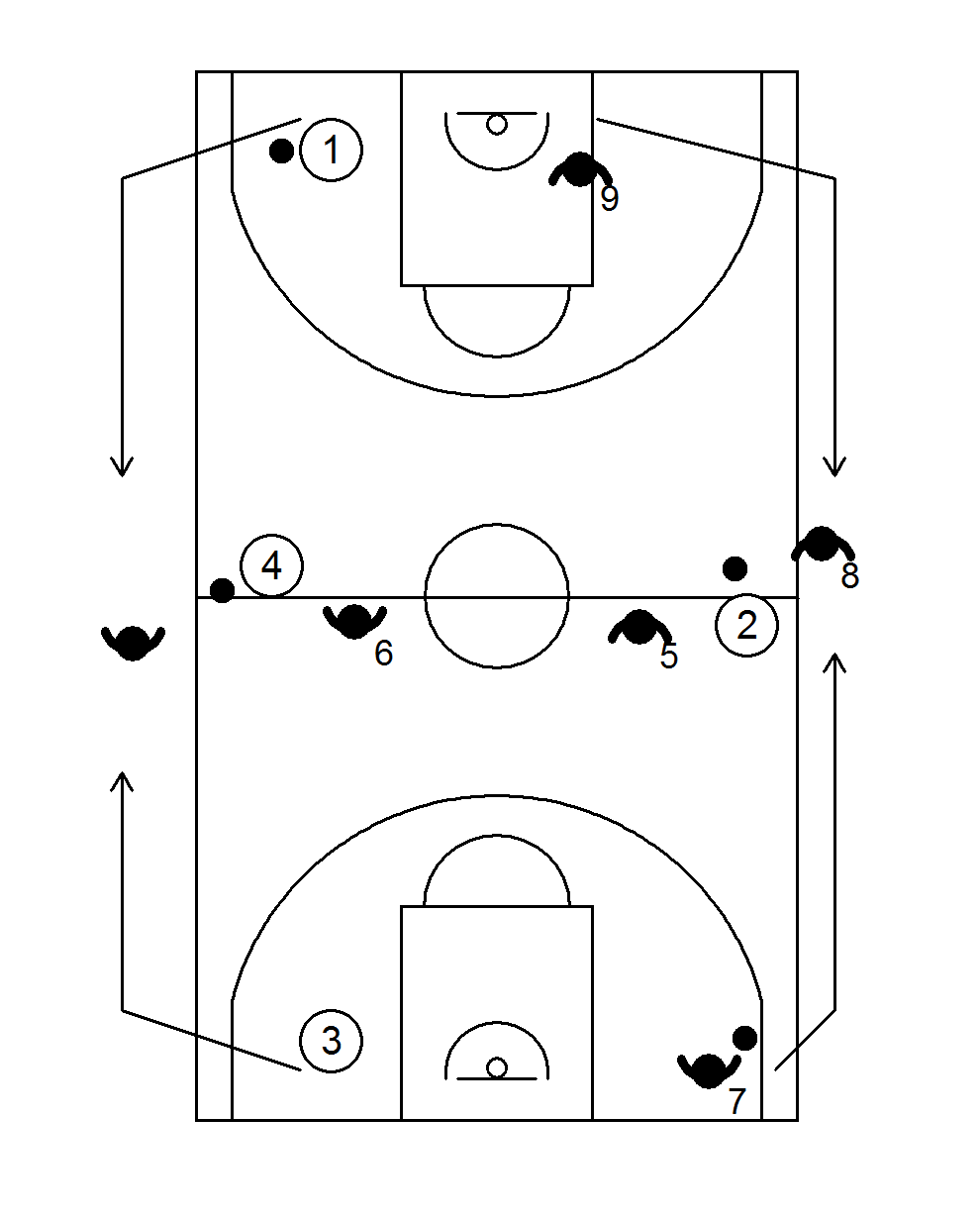
Requirements:
players must be able to defend the man with the ball individually (slides)
Goal: apply individual defensive technique in a simplified game situation
Organisation:
- attackers use one quarter of the playing field
- is not allowed to cross the baseline
- plays 1 against 1
- the defender may only step over the half-way line once the attacker has put one foot over the half-way line (the attacker may make feints, if the defender steps too early he must first put both his legs back behind the line)
- the defender first has to sprint to get his position between man and basket, then stay with slides between man and basket
- winner will attack on the other half of the court
- Loser keeps on defending in this quarter (turning in at the halfway line).
- the next pair starts when the predecessor takes the rebound.
Teaching Points:
- make sure you overtake the attacker by a large margin and only then take the defensive position.
- then immediately move backwards with slides
- In case of a defensive fault, the attacker is the winner.
Variations:
- let the defender keep his hands behind his back if you want to accentuate his footwork
- You can give good defenders a handicap by having them start 1 or 2 steps behind the attacker
- attackers can be slowed down by having them dribble behind their back in front of the 3-point line, etc.
- The teacher selects 2 taggers.
- They have to stay within their box (within the 4 pilons) and tap the basketballs away from the runners if they want to cross.
- So the runners have to dribble to the other side without losing their basketball.
- If a runner doesn't have the basketball with him, he is finished and automatically becomes a tagger.
- A tip you can give to the runners is that they shield the ball with their body.
- This means keeping your body between the ball and the opponent.
- The runners are not allowed to cross again until everyone has tapped or reached the other side.
- In the end, as the game progresses, you get more and more taps and fewer runners.
- The last remaining runner is the winner.
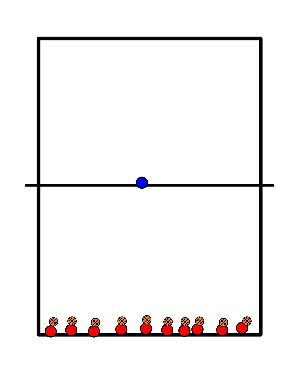
- 2 or 4 teams (1 or 2 fields)
- Each team has 1 ball and is at the head of the bucket
- Take turns shooting
- If you score then you may go to the other basket to shoot a free throw
- Is it touching, it is 1 point.
- At 5 points the team has won
- Possibly you can turn it into a conditioning training
- When a shot is missed
- There must then be run to the back line and back







